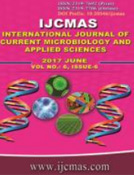


 National Academy of Agricultural Sciences (NAAS)
National Academy of Agricultural Sciences (NAAS)

|
PRINT ISSN : 2319-7692
Online ISSN : 2319-7706 Issues : 12 per year Publisher : Excellent Publishers Email : editorijcmas@gmail.com / submit@ijcmas.com Editor-in-chief: Dr.M.Prakash Index Copernicus ICV 2018: 95.39 NAAS RATING 2020: 5.38 |
The nature and magnitude of genetic divergence was estimated in 35 genotypes of tomato using Mahalanobis D2 – statistics. The genetic material revealed considerable amount of diversity for all the characters investigated. All the genotypes were grouped into 4 clusters. Maximum number of genotypes was accommodated in cluster III. The intra cluster distance was maximum in cluster III (3.103) and minimum in cluster IV (2.435). The inter cluster distance was found maximum to the tune of 4.790 between cluster I and IV and minimum (2.765) between cluster II and IV, indicating that hybridization between the genotypes from cluster I and IV can be utilized for getting superior recombinants/transgressive segregants in segregating generations of tomato. Principal component (PC) analysis depicted first four PCs with Eigen-value higher than 1 contributing 72.97% of total variability for different traits. The PC-I showed positive factor loadings for for most of the traits except fruit shape index, number of locules per fruit, pericarp thickness and harvest duration.
 |
 |
 |
 |
 |